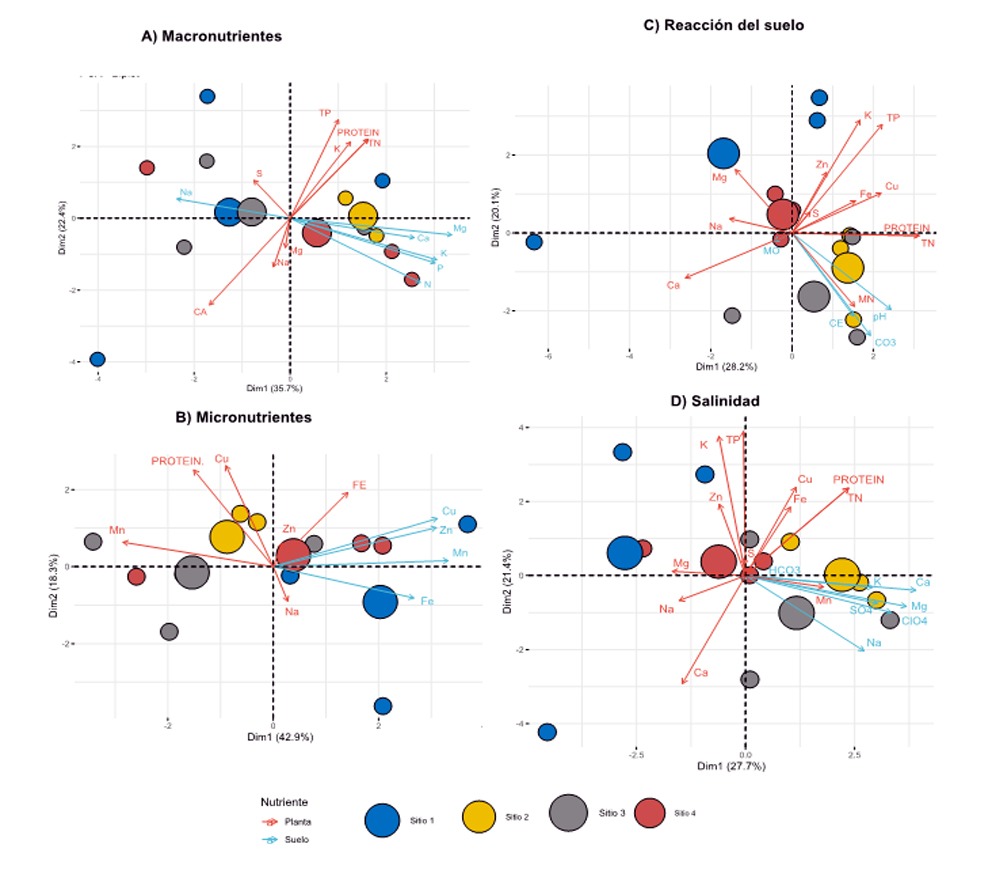Effect of soil physical and chemical properties on the nutritional status of nopal-vegetable (Opuntia ficus-indica (L.) Mill variety Milpa Alta
DOI:
https://doi.org/10.18387/polibotanica.60.18Keywords:
Opuntia ficus-indica (L.) Mill, ash, fiber, macronutrients, micronutrients, protein, soil salinityAbstract
Consumption of nopal-vegetable has increased in recent years, but there are few studies on how production systems affect its nutritional content and its relationship with the soil. This study aimed to determine the impact of soil physical and chemical properties on the nutritional characteristics of nopal-vegetable cladodes (Opuntia ficus-indica (L.) Mill. variety ‘Milpa Alta’). Soil and cladode samples were collected in four Family Production Units (FPUs) in ‘Milpa Alta’, Mexico City. A Principal Component Analysis (PCA) and a Structural Equation Model (SEM) were performed from the laboratory results. The physical and chemical analysis of the soils indicated a loamy texture with four variants, no compaction problems and high concentrations of inorganic N (N-NO3 + N-NH4) and extractable phosphorus. The PCA determined that soil N and P are related with the protein content in cladodes, and have an antagonistic relationship with soil pH and salinity. The MEE demonstrated that optimizing K levels could improve the protein quality of cladodes, while adequate control of Zn and carbonates in the soil avoids adverse effects on fiber content. The information resulting from this work shows that there are areas for improvement in production, in particular an adequate fertilization program would favor the nutritional quality of the nopal-vegetable.
References
Angulo-Bejarano, P. I., Martínez-Cruz, O., & Paredes-López, O. (2014). Phytochemical content, nutraceutical potential and biotechnological applications of an ancient Mexican plant: Nopal (Opuntia ficus-indica). Current Nutrition & Food Science, 10(3), 196-217. https://www.ingentaconnect.com/content/ben/cnf/2014/00000010/00000003/art00005
Association of Official Analytical Chemist. (1980). Official Methods of Analysis. AOAC.
Association of Official Analytical Chemist. (1990). Official Methods of Analysis of the Association of Official Analytical Chemists (Vol. II). AOAC.
Astello-García, M. G., Cervantes, I., Nair, V., Santos-Díaz, M. D. S., Reyes-Agüero, A., Guéraud, F., Negre-Salvayre, A., Rossignol, M., Cisneros-Zevallos, L., & Barba de la Rosa, A. P. (2015). Chemical composition and phenolic compounds profile of cladodes from Opuntia spp. cultivars with different domestication gradient. Journal of Food Composition and Analysis, 43, 119-130. https://doi.org/10.1016/j. jfca.2015.04.016
Atalah, E., y Pak, N. (1997). Aumente el consumo de verduras, frutas y legumbres. En C. Castillo, R. Uauy, y E. Atalah (Edits.), Guías de alimentación para la población chilena. (pp. 79-89). Imprenta La Nación.
Bejar-Pulido, S. J., Cantú Silva, I., Yáñez Díaz, M. I. y Luna Robles, E. O. (2020). Curvas de retención de humedad y modelos de pedotransferencia en un Andosol bajo distintos usos de suelo. Revista Mexicana de Ciencias Forestales, 11(59), 31-50. https://doi.org/10.29298/rmcf.v11i59.666
Béjar-Pulido, S. J., Cantú-Silva, I., & Luna-Robles, E. O. (2021). Effect of different land use on chemical properties of an Andosol in Michoacán, Mexico. Tropical and Subtropical Agroecosystems, 24(3), Article 121. http://dx.doi.org/10.56369/tsaes.3629
Betancourt-Domínguez, M. A., Hernández-Pérez, T., García-Saucedo, P., Cruz-Hernández, A., & Paredes-López, O. (2006). Physico-chemical changes in cladodes (nopalitos) from cultivated and wild cacti (Opuntia spp.). Plant Foods for Human Nutrition, 61, 115-119. Obtenido de https://doi.org/ 10.1007/s11130-006-0008-6
Blanco-Macías, F., Magallanes-Quintanar, R., Valdez-Cepeda, R. D., Vázquez-Alvarado, R., Olivares-Sáenz, E., Gutiérrez-Ornelas, E., y Vidales-Contreras, J. A. (2009). Comparación entre normas DNC y estándares nutrimentales de la técnica de curva límite: CASO Opuntia ficus-indica L. Revista Chapingo Serie Horticultura, 15, 217-223. http://www.scielo.org.mx/scielo.php?script=sci_arttext&pid=S1027-152X2009000200017&lng=es
Bonilla-Rodríguez, R. (2009). Agricultura y tenencia de la tierra en ‘Milpa Alta’: Un lugar de identidad. Argumentos, 22(61), 249-282. http://www.scielo.org.mx/scielo.php?script=sci_arttext&pid=S0187-57952009000300011&lng=es&tlng=es
Bonilla-Rodrígez, R. (2014). Urbanización rural y economía agrícola de sobrevivencia en la Delegación ‘Milpa Alta’. Argumentos, 27(74), 195-215. http://www.scielo.org.mx/scielo.php?script=sci_arttext&pid=S0187-57952014000100008&lng=es&tlng=es
Bremner, J. M. (1965). Inorganic forms of nitrogen. En A. G. Norman (Ed.), Methods of Soil Analysis. Part. 2. Chemical and Microbiological Properties (pp. 1179-1237). American Society of Agronomy. Agronomy Monograph 9.2.
Burgess-Conforti, J. R., Moore Jr., P. A., Owens, P. R., Miller, D. M., Ashworth, A. J., Hays, P. D., Evans-White, M. A., & Anderson, K. R. (2019). Are soils beneath coniferous tree stands more acidic than soils beneath deciduous tree stands? Environmental Science and Pollution Research, 26, 14920-14929. https://doi.org/10.1007/s11356-019-04883-y
Cárdenas, Y., Ríos-Silva, M., Huerta, M., López, M., Bricio-Barrios, J., Ortiz-Mesina, M., Urzúa, Z., Saavedra-Molina, A., & Trujillo, X. (2019). The comparative effect of nopal and mucilage in metabolic parameters in rats with a high-fructose diet. Journal of Medicinal Food, 22(5), 538-541. https://doi.org/10.1089/jmf.2018.0124
Casas, A., & Barbera, G. (2002). Mesoamerican domestication and diffusion. En P. S. Nobel, Cacti: Biology and uses (pp. 143-162). University of California Press.
Cornejo-Villegas, M. A., Acosta-Osorio, A. A., Rojas-Molina, I., Gutiérrez-Cortéz, E., Quiroga, M. A., Gaytán, M., Herrera, G., & Rodríguez-García, M. E. (2010). Study of the physicochemical and pasting properties of instant corn flour added with calcium and fibers from nopal powder. Journal of Food Engineering, 96(3), 401-409. https://doi.org/10.1016/j.jfoodeng.2009.08.014
Cushman, J. C., & Borland, A. M. (2002). Induction of Crassulacean acid metabolism by water limitation. Plant Cell and Environment, 25(2), 295-310. https://doi.org/10.1046/j.0016-8025.2001.00760.x
Fernández-Pavia, Y. L., García-Cué, J. L., López-Jiménez, A., y Mora-Aguilera, G. (2017). Inducción de deficiencias nutrimentales en nopal verdura Opuntia ficus indica (L.). Revista Mexicana de Ciencias Agrícolas, 6(6), 1417-1422. https://doi.org/10.29312/remexca.v6i6.586
Figueroa-Pérez, M. G., Pérez-Ramírez, I. F., Paredes-López, O., Mondragón-Jacobo, C. y Reynoso-Camacho, R. (2018). Phytochemical composition and in vitro analysis of nopal (O. ficus-indica) cladodes at different stages of maturity. International Journal of Food Properties, 21(1), 1728-1742. https://doi.org/10.1080/10942912.2016.1206126
Galicia-Villanueva, S., Escamilla-García, P. E., Alvarado-Raya, H., Aquino-González, L. V., Serna-Álvarez, H., y Hernández-Cruz, L. M. (2017). Plantación experimental de nopal para evaluación de sistemas de fertilización y extracción de mucílago. Revista Mexicana de Ciencias Agrícolas, 8(5), 1087-1099. https://doi.org/10.29312/remexca.v8i5.110
González, D., Ramírez, J. R., Mendoza, J. M., Mosqueda, S., & García-Muñoz, A. R. A. (2016). Estudio nutricional del nopal (Opuntia ficus-indica L. Miller) en sus diferentes tipos de cocción. CAUCE, 2-16.
González, M. R. (2010). Usos y significados del nopal, la tuna, el xoconostle y la grana cochinilla. Miradas y saberes de las mujeres en el sistema producto. En J. P. Mejorada (Comp.), Memorias del VII encuentro multidisciplinario de investigación (pp. 1). Universidad Nacional Autónoma de México.
Guo, L., Wu, G., Li, Y., Li, C., Liu, W., Meng, J., Liu, H., Yu, X., & Jiang, G. (2016). Effects of cattle manure compost combined with chemical fertilizer on topsoil organic matter, bulk density and earthworm activity in a wheat–maize rotation system in Eastern China. Soil and Tillage Research, 156, 140-147. http://dx.doi.org/10.1016/j.still.2015.10.010
Hernández-Urbiola, M. I., Pérez-Torrero, E., & Rodríguez-García, M. E. (2011). Chemical analysis of nutritional content of prickly pads (Opuntia ficus-indica) at varied ages in an organic harvest. International Journal of Environmental Research and Public Health, 8, 1287-1295. http://doi:10.3390/ijerph8051287
Inglese, P., Mondragón, C., Nefzaoui, A., y Sáenz, C. (2018). Ecología del cultivo, manejo y usos del nopal. Organización de las Naciones Unidas para la Alimentación y la Agricultura, Centro Internacional de Investigaciones Agrícolas en Zonas Áridas. https://openknowledge.fao.org/handle/20.500.14283/i7628es
Lefcheck, J. S. (2016). piecewiseSEM: Piecewise structural equation modelling in r for ecology, evolution, and systematics. Methods in Ecology and Evolution, 7(5), 573-579. http://doi:10.1111/2041-210X.12512
Maki-Díaz, G., Peña-Valdivia, C. B., García-Nava, R., Arévalo-Galarza, M. L., Calderón-Zavala, G., y Anaya-Rosales, S. (2015). Características físicas y químicas de nopal verdura (Opuntia ficus-indica) para exportación y consumo nacional. Agrociencia, 49(1), 31-51. http://www.scielo.org.mx/scielo.php?script=sci_arttext&pid=S1405-31952015000100003&lng=es&tlng=es
Martínez-Villavicencio, N., López-Alonzo, C. V., Pérez-Leal, R., y Basurto-Sotelo, M. (2011). Efectos por salinidad en el desarrollo vegetativo. Tecnociencia Chuhuahua, 5(3), 156-161. https://doi.org/10.54167/tch.v5i3.694
Medina-García, G., Zegbe, J. A., Ruiz-Corral, J. A., Casa-Flores, J. I., y Rodríguez-Moreno, V. M. (2021). Influencia del cambio climático en los requerimientos térmicos del nopal tunero (Opuntia spp.) en el centro-norte de México. Revista Bio Ciencias, Artículo e1007. https://doi.org/10.15741/revbio.08.e1007
Méndez-Gallegos, S. J., y García-Herrera, J. (2006). La tuna: producción y diversidad. Biodiversitas, 68, 1-15. https://www.biodiversidad.gob.mx/conabio/publicaciones/biodiversitas
Meraz-Maldonado, N., Valle-Guadarrama, S., Hernández-Morales, J., Anaya-Rosales, S., Rodríguez-Maciel, J. C., & Leyva-Ruelas, G. (2012). Quality of three sizes of prickly pear cactus stems (Opuntia ficus indica L.‘Atlixco’). African Journal of Agricultural, 7(32), 4512-4520. https://doi.org/10.5897/AJAR12.974
Missaoui, M., D’Antuono, I., D’Imperio, M., Linsalata, V., Boukhchina, S., Logrieco, A. F., & Cardinali, A. (2020). Characterization of micronutrients, bioaccessibility and antioxidant activity of prickly pear cladodes as functional ingredient. Molecules, 25(9), 2176. https://doi.org/10.3390/molecules25092176
Mitma-Ramírez, C. A. (2024). Propuesta de mejora en el uso de imágenes satelitales para mitigar la salinidad en zonas agrícolas de la región Ica: Caso TECNONAVAL. https://hdl.handle.net/20.500.12892/973
Molina, E., y Rodríguez, J. H. (2012). Fertilización con N, P, K, S, y curvas de absorción de nutrimentos en arroz var. Cfx 18 en Guanacaste. Agronomía Costarricense, 36(1), 39-51. http://www.scielo.sa.cr/scielo.php?script=sci_arttext&pid=S0377-94242012000100003&lng=en&tlng=es
Mondragón-Jacobo, C., y Méndez-Gallegos, S. J. (2018). Producción y utilización del nopal como hortaliza o Nopalitos. En P. Inglese, J. C. Mondragón, A. Nefzaoui, & C. Sáenz (Eds.), Ecología del cultivo, manejo y usos del nopal (pp. 244). Organización de las Naciones Unidas para la Alimentación y la Agricultura (FAO).
Oksanen, F. J. (2017). Vegan: Community Ecology Package (R package version 2.4. 3.). https://CRAN.R-project.org/package=vegan. 15 de abril de 2019.
Osorio-Córdoba, J., Pelayo-Zaldívar, C., Verde-Calvo, J. R., Ponce-Valadez, M., Díaz de León-Sánchez, F., Bosquez-Molina, E., y Rodríguez-Huezo, M. E. (2011). Conservación del nopal verdura “‘Milpa Alta’” (Opuntia ficus indica Mill.) desespinado en envases con atmósfera modificada. Revista Mexicana de Ingeniería Química, 10, 93-104. http://rmiq.org/iqfvp/eVol10No1.html
Perucini-Avendaño, M., Nicolás-García, M., Jiménez-Martínez, C., Perea-Flores, M. de J., Gómez-Patiño, M. B., Arrieta-Báez, D., & Dávila-Ortiz, G. (2021). Cladodes: Chemical and structural properties, biological activity, and polyphenols profile. Food Science and Nutrition, 9(7), 4007-4017. http://doi: 10.1002/fsn3.2388
Prosky, L., Asp, N. G., Schweizer, T. F., Devries, J. W., & Furda, I. (1988). Determination of insoluble, soluble, and total dietary fiber in foods and food products: interlaboratory study. Journal of the Association of Official Analytical Chemists, 71(5), 1017-1023. https://doi.org/10.1093/jaoac/71.5.1017
R Development Core Team. (2024). R: A Language and Environment for Statistical Computing (Version 4.2). [Software] R Foundation for Statistical Computing.
Reynolds, S. G., Arias-Jiménez, E., Mondragón-Jacobo, C., y Pérez-González, S. (2003). El nopal (Opuntia spp.) como forraje, Estudio FAO Producción y Protección Vegetal (Vol. 169). FAO.
Rives-Castillo, S. C. H., Correa-Pacheco, Z. M., Bautista-Baños, S., Ventura-Aguilar, R. I., Schettino-Bermudez, B. F., Ortega-Gudiño, P., y Barajas-Cervantes, A. (2021). Análisis químico proximal y térmico en harinas de productos residuales de nopal (Opuntia ficus-indica) para obtención de compuestos poliméricos biobasados. Agrociencia, 55(5), 403-416. https://doi.org/10.47163/agrociencia.v55i5.2516
Roldán-Cruz, E. I., y Chavarría-Miranda, H. (2022). Nopal/tuna, mercado y territorio en México: Un enfoque de capacidades. Eutopía, Revista de Desarrollo Económico Territorial, 21, 100-132. http://doi10.17141/eutopia.21.2022.5435
Salazar-Sosa, E., Trejo-Escareño, H. I., López-Martínez, J. D., Vázquez-Vázquez, C., Serrato-Corona, J. S., Orona-Castillo, I., y Flores-Márgez, J. P. (2010). Efecto residual de estiércol bovino sobre el rendimiento de maíz forrajero y propiedades del suelo. Terra Latinoamericana, 28(4), 381-390. https://www.terralatinoamericana.org.mx/index.php/terra/issue/view/47
Santander, J. S., Lira, B. P., Arteaga, K. A., & Camarillo, J. P. P. (2024). Physicochemical characterization of agricultural soils under a traditional system in the Mezquital Valley, Hidalgo. South Florida Journal of Development, 5(5), Article e3937. https://doi.org/10.46932/sfjdv5n5-017
Santiago-Lorenzo, M., López-Jiménez, A., Saucedo-Veloz, C., Cortés-Flores, J. I., Jaén-Contreras, D., y Suárez-Espinosa, J. (2016). Composición nutrimental del nopal verdura producido con fertilización mineral y orgánica. Revista Fitotecnia Mexicana, 39(4), 403-407. http://www.scielo.org.mx/scielo.php?script=sci_arttext&pid=S0187-73802016000400403&lng=es&tlng=es
Secretaría de Desarrollo Rural y Equidad para las Comunidades. (2016). La grandeza del nopal. SEDEREC. https://www.sepi.cdmx.gob.mx/storage/app/media/recetarionopal.pdf
Secretaría de Economía. (2006). Norma Mexicana NMX-FF-068-SCFI-2006, Hortaliza Fresca-Nopal Verdura (Opuntia spp.)-Especificaciones. Diario Oficial de la Federación. http://www.economia-nmx.gob.mx/normas/nmx/2007/nmx-ff-068-scfi-2006.pdf. 12 de mayo de 2020.
Secretaría de Protección Civil de la CDMX. (2014). Atlas de Peligros y Riesgos de la Ciudad de México. Mapa de riesgos de la Delegación ‘Milpa Alta’. Secretaría de Protección Civil.
Secretaría del Medio Ambiente y Recursos Naturales. (2002). Norma Oficial Mexicana NOM-021-RECNAT-2000, Que establece las especificaciones de fertilidad, salinidad y clasificación de suelos. Estudios, muestreo y análisis. Diario Oficial de la Federación. http://www.ordenjuridico.gob.mx/Documentos/Federal/wo69255.pdf. 12 de mayo de 2020.
Servicio de Información Agroalimentaria y Pesquera. (2021). Avances de siembras y cosechas. Resumen por Estado. Zumpango, México. Diciembre 2020. Riego+temporal. Perennes. Nopalitos. http://infosiap.siap.gob.mx:8080/agricola_siap_gobmx/ResumenProducto.do
Servicio de Información Agroalimentaria y Pesquera. (2024). Estad´siticas de Producción Agrícola. https://www.gob.mx/siap/acciones-y-programas/produccion-agricola-33119
Silva, M. A., Gonçalves-Albuquerque, T., Pereira, P., Ramalho, R., Vicente, F., Oliveira, M. B. P. P., & Costa, H. S. (2021). Opuntia ficus-indica (L.) Mill.: A multi-benefit potential to be exploited. Molecules, 26(4), 951. https://doi.org/10.3390/molecules26040951
Solano, L., Meertens, L., Peña, E., y Arguello, F. (1998). Deficiencia de micronutrientes. Situación actual. Anales Venezolanos de Nutrición, 11(1), 48-54. https://www.analesdenutricion.org.ve/ediciones/1998/1/art-9/
Tavera-Cortés, M. E., Escamilla-García, P. E., & Pérez-Soto, F. (2018). Impacts on productivity through sustainable fertilization of nopal (Opuntia ficus-indica) crops using organic compost. Journal of Agricultural Science, 10(4), 297-305. http://doi.org/10.5539/jas.v10n4p297

Downloads
Published
License
Copyright (c) 2025 POLIBOTANICA

This work is licensed under a Creative Commons Attribution-NonCommercial-ShareAlike 4.0 International License.

Polibotánica by Departamento de Botánica de la Escuela Nacional de Ciencias Biológicas del Instituto Politécnico Nacional se distribuye bajo una Licencia Creative Commons Atribución-NoComercial-CompartirIgual 4.0 Internacional.



















